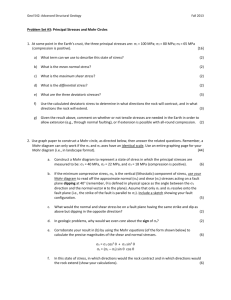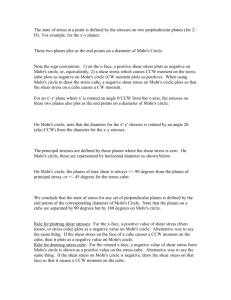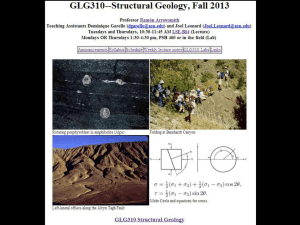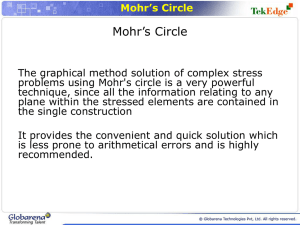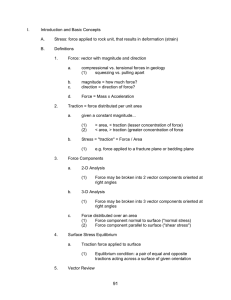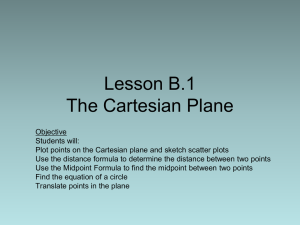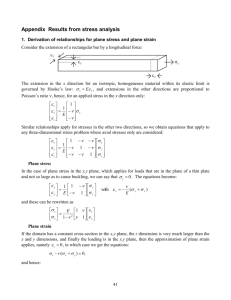Lab 4
advertisement
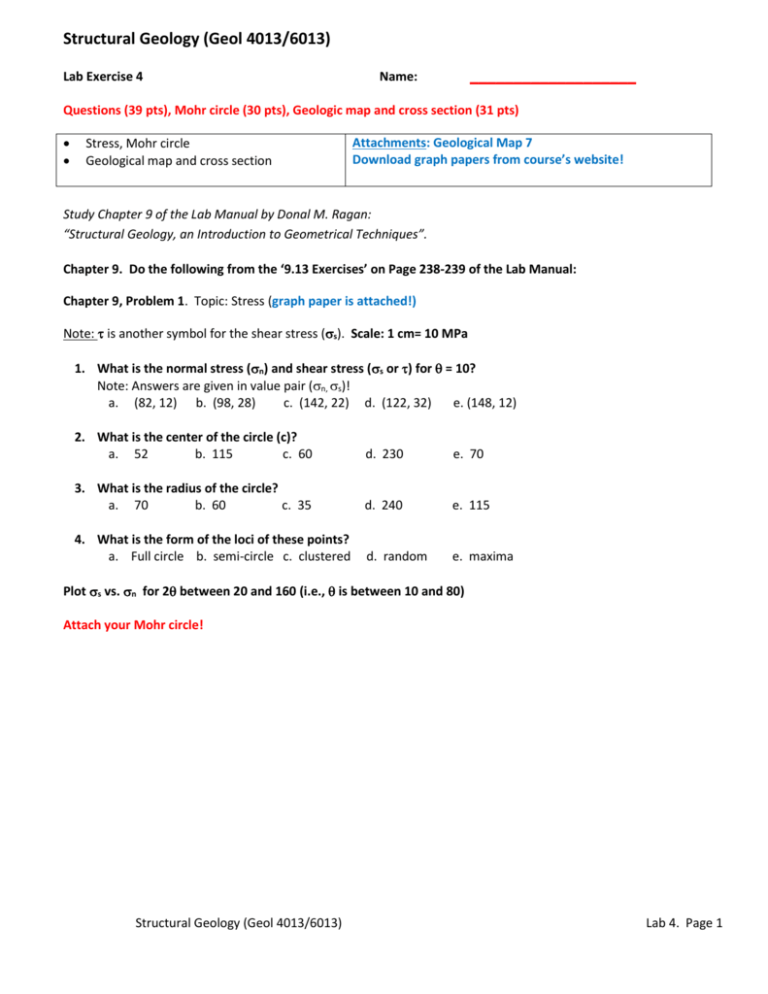
Structural Geology (Geol 4013/6013) Lab Exercise 4 ___________________ Name: Questions (39 pts), Mohr circle (30 pts), Geologic map and cross section (31 pts) Stress, Mohr circle Geological map and cross section Attachments: Geological Map 7 Download graph papers from course’s website! Study Chapter 9 of the Lab Manual by Donal M. Ragan: “Structural Geology, an Introduction to Geometrical Techniques”. Chapter 9. Do the following from the ‘9.13 Exercises’ on Page 238-239 of the Lab Manual: Chapter 9, Problem 1. Topic: Stress (graph paper is attached!) Note: is another symbol for the shear stress (s). Scale: 1 cm= 10 MPa 1. What is the normal stress (n) and shear stress (s or ) for = 10? Note: Answers are given in value pair (n, s)! a. (82, 12) b. (98, 28) c. (142, 22) d. (122, 32) e. (148, 12) 2. What is the center of the circle (c)? a. 52 b. 115 c. 60 d. 230 e. 70 3. What is the radius of the circle? a. 70 b. 60 c. 35 d. 240 e. 115 4. What is the form of the loci of these points? a. Full circle b. semi-circle c. clustered d. random e. maxima Plot s vs. n for 2 between 20 and 160 (i.e., is between 10 and 80) Attach your Mohr circle! Structural Geology (Geol 4013/6013) Lab 4. Page 1 Chapter 9, Problem 2, Page 239, Part a, b, and c (3 sheets of graph paper are needed!) Topic: Given the normal and shear stresses (n, s) on two planes on Figure 9.39a, 9.39b, and 9.39c, find the principal stresses (1 and 3). Note: The sense of the shear stresses: CW (-) and CCW (+)! For normal stress: Tension is -, compression is + Hint: Set up the coordinate system on a graph paper. Use the arbitrary scale of 1 cm = 10 units for n and s on a graph paper. Plot each pair of the given normal and shear stress (n, s) as two points, and find the center of the circle, by connecting the two points with a line, and then drawing the intersection of its perpendicular bisector with the n axis. Having the center (c) (at the intersection of the bisector and the n axis), find the radius (r), knowing that the two points lie on the circle. With the center and radius determined, draw the circle, and then find the intersection of the Mohr circle with the n axis. Read the principal stresses: 1 and 3. NOTE: You need three graph papers (i.e., plots) for this problem (for parts a, b, and c)! download graph paper from course’s website. NOTE: For part (a) the pair of normal and shear stresses (n, s) are: (100, -20) & (10, 20) Part (a) 5. What is the center for the Mohr circle for part (a)? a. 20 b. 89 c. 55 d. 18 e. 32 6. What is the radius for the Mohr circle for part (a)? a. 21 b. 80 c. 12 d. 32 e. 50 7. What is the maximum principal stress (1) for part (a)? a. 105 b. 58 c. 34 d. 18 e. 80 8. What is the minimum principal stress (3) for part (a)? a. 22 b. 10 c. 1 d. 14 e. 5 NOTE: For part (b) the pair of normal and shear stresses (n, s) are: (200, 30) & (50, -30) Part (b) 9. What is the center for the Mohr circle for part (b)? a. 126 b. 59 c. 85 d. 28 e. 156 10. What is the radius for the Mohr circle for part (b)? a. 26 b. 81 c. 25 d. 30 e. 56 11. What is the maximum principal stress (1) for part (b)? a. 105 b. 38 c. 134 d. 140 e. 207 12. What is the minimum principal stress (3) for part (b)? a. 20 b. 44 c. 10 d. 30 e. 15 NOTE: For part (c) the pair of normal and shear stresses (n, s) are: (150, -10) & (-25, 10) Part (c) 13. What is the center for the Mohr circle for part (c)? a. 12 b. 82 c. 45 d. 63 e. 76 14. What is the radius for the Mohr circle for part (c)? a. 27 b. 60 c. 18 d. 28 e. 88 15. What is the maximum principal stress (1) for part (c)? a. 95 b. 151 c. 39 d. 82 e. 60 16. What is the minimum principal stress (3) for part (c)? a. -26 b. -30 c. 18 d. -46 e. 34 Structural Geology (Geol 4013/6013) Lab 4. Page 2 /30 pts Chapter 9, Page 239, Problem 3. (3 sheets of graph paper are needed!) Given the state of stress on the faces of the squares on Figures 9.40a, b, and c, find the normal and shear stresses (n and s) on the inclined plane inside the boxes for each part! NOTE 1: The sense of the shear stresses: CW (-) or CCW (+)! For normal stress: Tension is -, compression is + NOTE 2: Figure 9.40a does not have a shear stress! What does this mean? NOTE 3: is the acute angle, read from 1 to the normal of a plane! This means that you first need to draw a dashed line normal (i.e., perpendicular line) to each of the inclined planes and then find from 1! Draw the Mohr circle as it was described in Problem 2 above, for parts a, b, and c. Mark 1 and 3. From the Mohr circle, read the angle 2 for the two faces of Figures 9.40a, b, and c (find 2 for the top face). Use half of this angle (i.e., ) to draw the orientation (i.e., vector) of 1 on Figure 9.40a, b, and c. Having 1 on each Figure, plotted with red pencil, find the acute angle () from it to the normal of the inclined plane inside each box (again watch for its sense; CW or CCW). Use twice this angle (i.e., 2), and plot the plane as a point on the Mohr circle. Read the coordinates of this point (n and s) for the inclined plane. Divide this angle by two (i.e., find ) for each case, and then plot the orientation of 1 with respect to the two faces of the square for Figure 9.40a, b, and c with a red pencil. Determine the angle that 1 makes with the normal (n) of the inclined plane for Figure 9.40a, b, and c Go back to the Mohr circle for each Figure, and plot the inclined plane with blue pencil. Label it as ‘ip’ Read the normal and shear stress for the inclined plane ‘ip’ for Figures 9.40a, b, and c. NOTE: For part (a) the normal and shear stresses (n, s) are: (200, 0) & (50, 0) Part (a) 17. What is for the inclined plane in part (a)? a. -12cw b. 89ccw c. 25ccw d. -49cw 18. What is n for the plane inside the box? a. 160 b. 78 c. 101 d. 114 19. What is s for the plane inside the box? a. 11 b. -73 c. -42 d. -33 e. -66cw e. 25 e. 80 NOTE: For part (b) the normal and shear stresses (n, s) are: (175, -20) & (25, 20) Part (b) 20. What is for the top face in part (b)? a. -26.5 b. -59 c. 15 d. -28 e. -7.5 21. What is n for the plane inside the box? a. 155 b. -68 c. 72 d. 36 e. -50 22. What is s for the plane inside the box? a. -31 b. 18 c. 55 d. 35 e. -65 NOTE: For part (c) the normal and shear stresses (n, s) are: (30, -15) & (90, 15) Part (c) 23. What is for the side face in part (c)? a. 13.5ccw b. -28cw c. 55ccw d. -60cw e. -76cw 24. What is n for the plane inside the box? a. 88 b. 68 c. 52 d. 13 e. 60 25. What is s for the plane inside the box? a. 10 b. 46 c. -10 d. -17 e. 29 You should have three Mohr circles: one for each sub-figure! Scale: 1 cm = 10 stress units Structural Geology (Geol 4013/6013) Lab 4. Page 3 /31 pts Problem 4. Interpretation of geological map and constructing a cross section Topic: Geologic map with fault, dike, and unconformity Map 7 (attached) shows the geology of deformed Paleozoic igneous and sedimentary rocks. The structural contours are plotted as thin, straight lines. Scale: 1:40,000 a. b. c. d. Homogeneously and thinly color the Ordovician Sandstone (e.g., with an orange highlighter pen) Determine the attitude (i.e., strike, true dip ) of the Ordovician sandstone in the three exposed areas Determine the attitude (strike, true dip ) of the limestone Using the nomogram or formula, convert the true dips () to apparent dips () for the sandstone (in all three spots) and the limestone in one spot, along the E-W line of section AB. Hint: You first need to find the acute angle between the section (traverse, projection) line AB and the strikes () for each set of units (this is the right column of the nomogram! e. Draw the topographic profile and the geologic cross section along AB with no vertical exaggeration! NOTE: ATTACH YOUR MAP AND CROSS SECTION FOR CREDIT! f. Answer the following questions (put your answers in the following table): 26. What is the attitude (strike, true dip) of the Ord. sandstone west of western fault? a. N23E, 10NW b. N11W, 13E c. 169, 12SW d. S13E, 40SW e. N16E, 10SE 27. What is the attitude (strike, true dip) of the Ord. sandstone east of western fault? a. N23E, 10NW b. N11W, 13E c. 169, 12NE d. S13E, 40NE e. N16E, 10NW 28. What is the attitude (strike, true dip) of the Ord. sandstone west of eastern fault? a. N13E, 10SE b. N11W, 18SW c. 210, 24S d. N13E, 40SE e. N10W, 50SW 29. What is the attitude (strike, true dip) of the Ord. sandstone in the northern part? a. N67W, 8NE b. S65E, 63NE c. 270, 32S d. N13E, 40NW e. N16E, 10SE 30. What is the apparent dips () of the Ord. Sandstone west of western fault? a. 3 b. 5 c. 6 d. 12 e. 15 31. What is the apparent dips () of the Ord. Sandstone east of western fault? a. 3 b. 7 c. 6 d. 12 e. 15 32. What is the apparent dips () of the Ord. Sandstone west of eastern fault? a. 3 b. 7 c. 6 d. 12 e. 15 33. What is the apparent dips () of the Ord. Sandstone in the northern part? a. 3 b. 7 c. 6 d. 12 e. 15 34. What is the attitude of the fold axis? a. N11W, 00 b. 011, 00 c. 000, 00 d. N0E, 00 e. 180, 00 35. Intrusion of the dike occurred before folding? a. True b. False 36. The western fault post-dates the fold? a. True b. False 37. The eastern fault post-dates the eastern dike? a. True b. False 38. The eastern dike is older than the Carboniferous limestone? a. True b. False 39. The eastern granite intrusion is younger than the eastern fault? a. True b. False Structural Geology (Geol 4013/6013) Lab 4. Page 4
